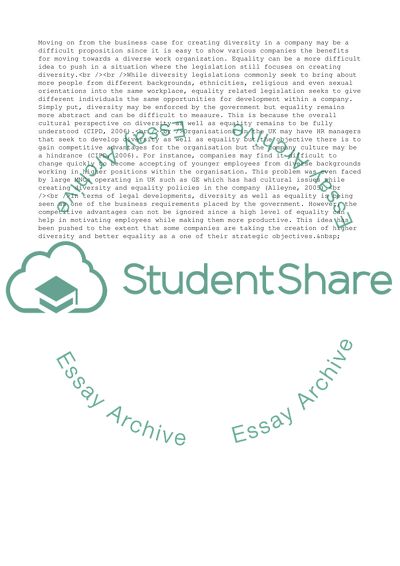Cite this document
(Diversity, Fairness and Equality Coursework Example | Topics and Well Written Essays - 2500 words, n.d.)
Diversity, Fairness and Equality Coursework Example | Topics and Well Written Essays - 2500 words. https://studentshare.org/business/1718906-there-is-a-growing-body-of-research-showing-that-diversity-has-outlived-its-usefulness-susan-scott-parker-argues-that-it-is-time-to-move-on-from-the-business-case-for-diversity-and-fairness-equality-should-be-back-on-the-business-agenda-discuss
Diversity, Fairness and Equality Coursework Example | Topics and Well Written Essays - 2500 words. https://studentshare.org/business/1718906-there-is-a-growing-body-of-research-showing-that-diversity-has-outlived-its-usefulness-susan-scott-parker-argues-that-it-is-time-to-move-on-from-the-business-case-for-diversity-and-fairness-equality-should-be-back-on-the-business-agenda-discuss
(Diversity, Fairness and Equality Coursework Example | Topics and Well Written Essays - 2500 Words)
Diversity, Fairness and Equality Coursework Example | Topics and Well Written Essays - 2500 Words. https://studentshare.org/business/1718906-there-is-a-growing-body-of-research-showing-that-diversity-has-outlived-its-usefulness-susan-scott-parker-argues-that-it-is-time-to-move-on-from-the-business-case-for-diversity-and-fairness-equality-should-be-back-on-the-business-agenda-discuss.
Diversity, Fairness and Equality Coursework Example | Topics and Well Written Essays - 2500 Words. https://studentshare.org/business/1718906-there-is-a-growing-body-of-research-showing-that-diversity-has-outlived-its-usefulness-susan-scott-parker-argues-that-it-is-time-to-move-on-from-the-business-case-for-diversity-and-fairness-equality-should-be-back-on-the-business-agenda-discuss.
“Diversity, Fairness and Equality Coursework Example | Topics and Well Written Essays - 2500 Words”. https://studentshare.org/business/1718906-there-is-a-growing-body-of-research-showing-that-diversity-has-outlived-its-usefulness-susan-scott-parker-argues-that-it-is-time-to-move-on-from-the-business-case-for-diversity-and-fairness-equality-should-be-back-on-the-business-agenda-discuss.


